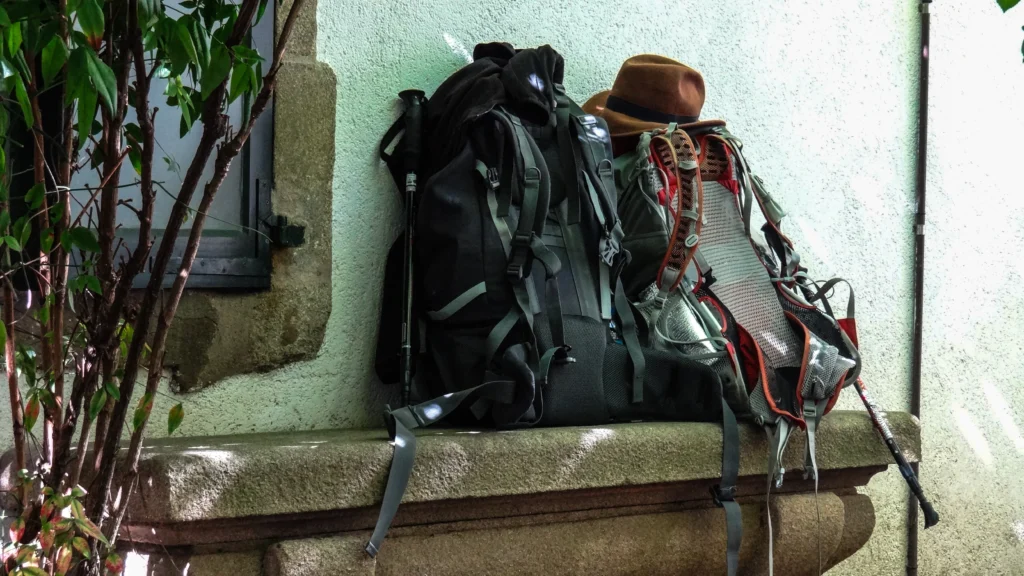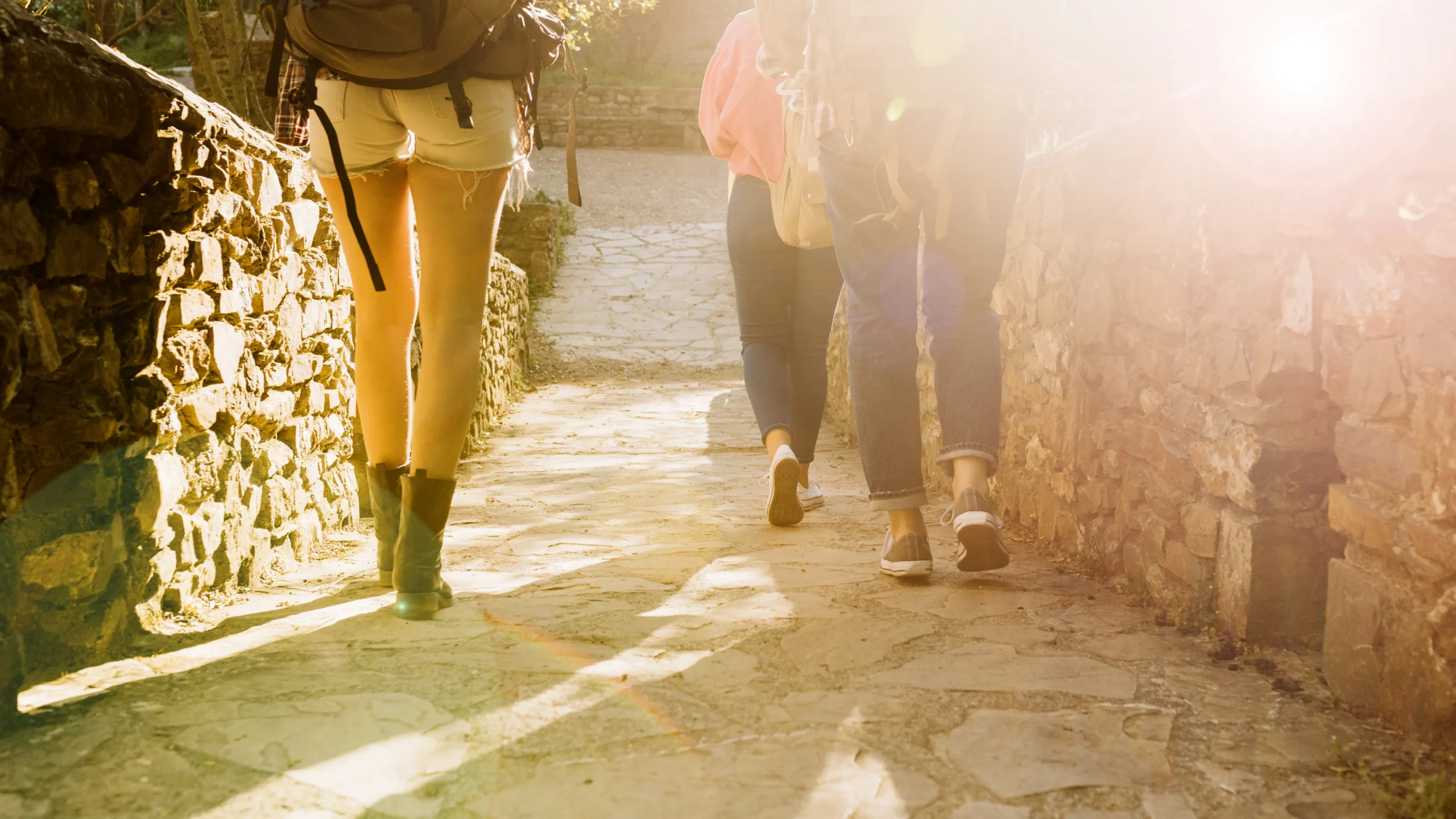Resume este artículo con IA
Choosing the right clothes for the Camino de Santiago helps you avoid chafing, sudden temperature changes, and unnecessary weight. The official guidelines are clear: pack light, adapt to the season, always use sun protection, and never wear brand-new clothes on the first day. A minimalist approach keeps your backpack lighter and makes it easier to wash and dry your clothes at the end of each stage.
Quick Checklist: Essential Clothing for the Camino de Santiago
Before diving into seasonal packing, here’s the basic clothing kit that always works for your first Camino de Santiago. Think light, breathable, and quick-drying.
- Technical T-shirts (2): polyester/fine merino, quick-dry.
- Convertible pants (1) + shorts (1): detachable if you like to alternate.
- Underwear (3) and seamless socks (3): if you wash daily, this is enough.
- Waterproof layer: breathable rain jacket or poncho that covers your backpack.
- Backpack rain cover: essential if there’s a chance of rain.
- Light fleece or thin sweater: for nights and early mornings.
- Flip-flops: for showers and to let your feet rest.
- Swimsuit (depending on route/season): rivers, beaches, pools.
- Hat/neck gaiter/gloves (for cold weather).
- Trekking sandals (for hot weather or active rest).
- Minimal toiletry kit + multipurpose soap bar and microfiber towel.
About Footwear
For most seasons, trekking shoes are best—they’re more comfortable than classic boots while still giving you the protection you need for long walking days.
In the hotter months, trekking sandals are also a great option for certain sections of the Camino. They let you walk comfortably while keeping your feet well-ventilated.
In summer, your backpack shouldn’t weigh more than 10% of your body weight, since clothing for that season is lighter and takes up less space. And as we always say: forget the “just in case” items—they have no place on the Camino.
What to Wear on the Camino de Santiago in Summer
The priority is breathability and sun protection. Use light, quick-drying clothing and apply high SPF sunscreen; add a cap, visor, or hat to avoid heatstroke. A light waterproof layer is still smart in case of sudden weather changes.
Summer clothing list:
- 2 breathable T-shirts.
- 1 lightweight shirt for evenings (to visit towns without looking “in hiking mode”).
- 1 pair of shorts + 1 pair of convertible pants.
- 3 sets of underwear and 3 pairs of seamless socks.
- Thin sweater (lightweight, perfect for cool evenings).
- Rain jacket and rain pants (a must in Galicia).
- Flip-flops + swimsuit.
Footwear:
- Trekking shoes (cooler than boots) for trails and paths.
- Trekking sandals for hot or paved stretches.
Field tips:
- Wash clothes as soon as you arrive: shirts and socks dry within hours.
- Avoid heavy cotton: it dries slowly and clings to the skin.
- Hat/visor and sunscreen: the Galician sun can be deceiving.
Personally, trekking sandals save me on hot asphalt stretches: ventilated feet and no blisters at the end of the day.
What to Wear on the Camino de Santiago in Winter
When it’s cold, use the classic three-layer system: breathable thermal base, insulating mid-layer, and waterproof/windproof outer layer. The goal is to block wind and rain without carrying unnecessary weight. Add a hat, neck gaiter, and gloves to keep warm without bulky clothing.
Winter clothing list:
- 2 thermal shirts + 2 thin cotton shirts for hostel use.
- Thermal tights (short under pants or long as main).
- Waterproof hiking pants.
- Technical breathable fleece + one thick sweater.
- Waterproof cape or poncho that covers your backpack.
- Hat, gloves, neck gaiter.
- 3 sets of underwear and 3 pairs of socks (add thicker socks if you get cold easily).
- Flip-flops (for showers and rest).
Footwear:
- Waterproof hiking boots (Gore-Tex, mid/high cut), already broken in.
In winter, I prefer technical layers: lighter and drier even when the day starts cold. And boots must be broken in—try them at home, not on the Camino.
What to Wear on the Camino de Santiago in Spring and Autumn
Spring and autumn can be tricky to pack for. Thin layers that you can easily add or remove work best. Breathable shirts, a light warm layer, and a waterproof windbreaker cover most situations. Days are mild, but wind and rain can show up without warning, so prioritize quick-drying fabrics to keep your clothing rotation manageable.
Spring & autumn clothing list:
- Focus on wind and rain, not cold: breathable rain jacket, backpack cover, and light layers.
- Technical clothing like in winter, but without bulky items.
- Alternate between shoes and boots depending on the terrain (wet ground vs. dry trails).
Practical list:
- 2 technical T-shirts + 1 light thermal.
- Waterproof hiking or convertible pants with thin leggings underneath.
- Light fleece, neck gaiter, and cap.
- 3 sets of underwear/3 seamless socks.
- Rain jacket and backpack cover always at hand.
When I feel damp wind, I pull up a thin neck gaiter and tighten my rain jacket cuffs: comfort changes instantly.
Footwear for the Camino: Boots, Shoes, and Sandals (When to Use Each)
Boots (Gore-Tex, mid/high cut)
- Best for winter, rocky or muddy stages.
- Provide support and protection but less ventilation.
- Breaking them in before the Camino is non-negotiable.
Trekking shoes
- Perfect for summer and dry seasons.
- Lighter and cooler; good grip on trails and paths.
- With technical socks, you avoid overheating.
Trekking sandals
- Useful in hot or urban stretches, and as a backup at the end of the day.
Socks & foot care
- Choose seamless socks; use anti-blister models if needed.
- Keep nails short, use light moisturizer, and check pressure points after each stage.
My favorite “anti-blister” combo: seamless socks and changing them as soon as I arrive—cheap and effective.
Common Mistakes (and How to Avoid Them)
Choosing clothes for the Camino can be tricky, and mistakes are easy to make. To help you pack a comfortable and practical backpack, here are the most common errors—and why to avoid them—so you can start your route prepared.
- Wearing new boots on day one → Break them in with 10–15 km walks beforehand.
- Thick cotton → dries slowly and chills you. Choose technical fabrics.
- Heavy backpack → apply the 10% rule and remove duplicates.
- No rain gear in Galicia → always carry a poncho/rain jacket.
- Socks with seams → cause friction and blisters: swap for technical ones.
- Not alternating footwear → use sandals for hot days or rest.
- Not washing upon arrival → clothes won’t dry in time. Wash immediately.
I learned quickly: “just in case” items end up being dead weight. Less is more.
How to Wash and Dry Clothes in Hostels in 20 Minutes
- On arrival: shower + soak shirt and socks with soap bar.
- Press gently without twisting (protects fibers).
- Roll in a microfiber towel and press to remove water.
- Hang on a clothesline or rope; if humid, place near (not on) a heat source.
- Plan B: carry an extra pair of socks in case drying takes longer.
FAQs
How many sets of underwear do I need if I wash daily?
Three (underwear + socks) are enough: one to wear, one washing, one dry.
Gore-Tex boots or shoes in summer?
Shoes for heat and dry stages; boots for mud/rock. Alternate depending on the section.
Swimsuit on inland routes?
Yes: rivers and natural pools are common. If you don’t use it, it hardly weighs anything.
Rain jacket or poncho?
Poncho covers the backpack and ventilates better; jacket protects better in wind. Choose based on route and preference.
How do I keep my backpack under 10%?
Weigh it packed. Remove duplicates, swap cotton for technical fabrics, and minimize toiletries.





